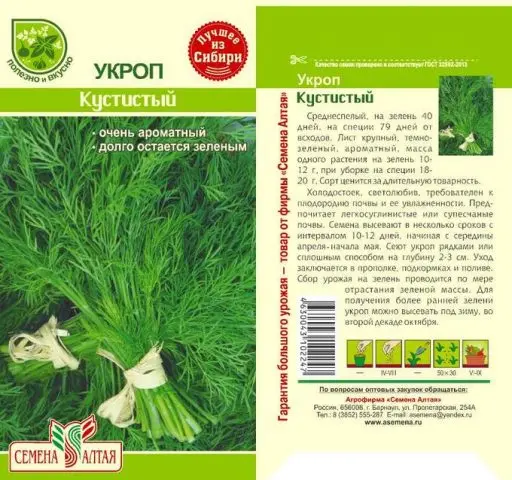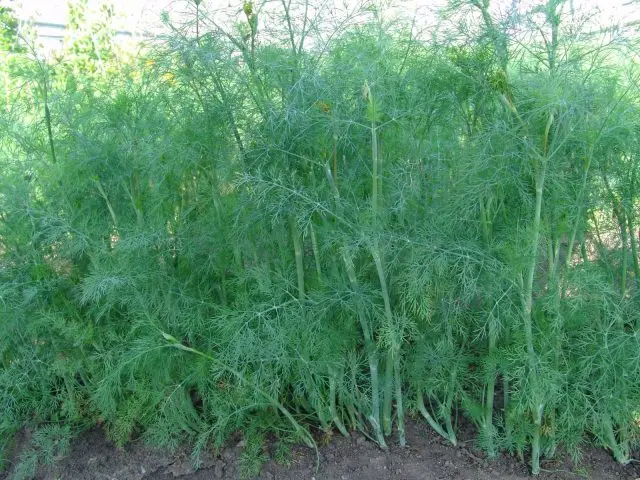Contents
Dill Bushy is a new variety with an average ripening period. According to the State Register of the Federation, the herbaceous culture is intended for cultivation in small farms, on household plots, garden and garden areas.

Description of the dill variety Bushy
Dill variety Bushy belongs to the group of abundant leafy type. In height, the bush grows to 150-180 cm. The shape is compact. The socket is up. The height reaches 35-40 cm. As a rule, 10-12 leaves grow on it.
Dill bushy due to the close internodes forms a large amount of foliage. The leaves are large, dark green in color, with a slight wax coating. The shape is strongly dissected, with flattened lobes. Greens are soft and juicy. The aroma is rich, due to the high content of essential oils.
The plant is cultivated in order to obtain spices, herbs. Used for canning, salting, decorating fresh salads, hot dishes. Suitable regions for planting: Crimea, Far East, Central regions, Siberia, Urals, North Caucasus.
Productivity
The total time from sowing to harvest is 30-40 days. Seeds ripen in 70-80 days. From one bush, 10-15 g of greenery or 3 kg per 1 sq. m. Harvest for spices from one bush 15-18 g or 3,4 kg per 1 sq. m. Gradual removal of leaves is possible.
Dill Bushy, like other varieties, is afraid of low temperatures. Therefore, a sharp temperature drop can cause crop loss. An unfavorable phenomenon for a herbaceous crop is the lack of irrigation. In this case, the foliage turns yellow, the presentation and taste are lost. The bush has a more modest size compared to the photo if the bushy dill is planted in poor soil.
Stability
As already mentioned, bushy dill does not tolerate cold weather. The plant is moisture-loving, therefore it reacts sharply to a lack of liquid in the soil. It is not affected by pests. Resistant to the main disease of this type of crop – powdery mildew. Fungal diseases are rare.
Advantages and disadvantages
Despite the fact that the variety is considered relatively new, most gardeners have already identified the pros and cons. Advantages of dill bushy:
- a lot of greenery;
- universal application;
- retains freshness for a long time;
- excellent taste;
- disease resistance.
The disadvantage is low frost resistance. Return frosts can harm the whole garden. Late spring does not rise for a long time. The first seedlings appear after the earth has completely warmed up.

Rules of landing
In order to receive dill of the Bushy variety such as in the photo, you should follow the recommendations for planting, as well as listen to the reviews of experienced gardeners.
- The fragrant plant is sown directly in open ground.
- Well-lit areas or beds in partial shade are suitable for planting.
- The culture prefers light loamy, sandy loamy, well-cultivated, neutral soils.
- Not suitable for herbaceous culture acidic soil.
- Since autumn, the site must be fertilized. Organic supplements or potassium-phosphorus preparations are most suitable for this.
- Sowing seeds is carried out in early spring or before winter. Apply multiple landing in the warm season with a difference of 10-12 days.
- Dill bushy should not be planted next to celery or in areas where this vegetable grew last year.
- The maximum growth of the plant occurs at a temperature of + 16-18 °C.
- The depth of seed placement is not more than 2 cm.
Growing Dill Bushy
The variety does not require special attention. After the appearance of seedlings, the planting should be thinned out. The distance between plants should be within 8-10 cm. Dill bushy requires a larger feeding area. Be sure to loosen the aisles. Weed grass is removed, as it clogs young dill and does not allow it to fully develop.
The fragrant plant responds well to watering. During the heat, the beds should be watered daily. On cool days, 1 time in 2-3 days will be enough. Some vegetable growers additionally feed dill, using potassium-phosphorus fertilizers for this. With the right dosage, these elements strengthen the culture. Boron has a similar effect. It is better to refuse nitrogen preparations.
Diseases and pests
Varieties Bushy has strong immunity to various fungal diseases characteristic of dill, in particular to powdery mildew. Therefore, preventive spraying is not necessary. It is better to perform a disinfectant treatment of seeds.
Sometimes fennel is sown in winter for an early harvest. The grown bushes are stronger, as the seed has been stratified in frozen soil.
Treatment with biostimulants has a positive effect on plant immunity. You can use both folk remedies and chemicals.
Conclusion
Dill Bushy is a variety that is grown in open ground almost throughout Our Country. In colder areas, shelter will be needed. Does not need special care. The plant has good immunity and is extremely rarely exposed to ailments.









